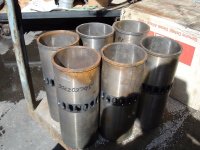Hello gentleman and ladies
I have recently taken delivery of my dream boat, 1987 Ocean 48 SS with a pair of DD 671 T's 485 HP. I brought the boat back to Georgian Bay from the south end of Lake Michigan several weeks back in a total of 21 running hours over two days, she's been in fresh water her whole life.
I read that i should keep both in the 1950-2150 RPM range to get her up and over the engines step to ensure the fuel and turbos were doing their cooling job.
She ran flawlessly with consistent oil pressure and temps on both. We were running at a steady 22 knots and burning fuel at 37 gph over the 510 miles.
My question is that the starboard engine burned a gallon of oil on each 10-1/2 hour leg while the port was negligible maybe 2 quarts. During start up they both smoke but the stbd is heavy, almost embarrassingly in the marina... even when i get back into the marina after running for several hours its more pronounced than the port.
There are very few leaks if any on either. Both engines are low in hours approx 1800 hours each.
They run like freight trains for the boats wet weight...
I have no complaints, but I am concerned if the stbd may start to worsen and end up with a catastrophic failure.
On a thread i read today, in one case, it sounded like a cylinder valve guide let go which could explain or as mentioned rings and liners may be at the root.
Knowing what I have outlined would someone have a hunch or guess, and if, so what is involved in a guide replacement and would a compression test reveal that problem or worse too much ring clearance?
Also if it is rings and liners , can an old BBC engine motor head drag racer enthusiast , me... be able to navigate through the above scenarios... ?
I am aware of the interior I have to open up, but the nice thing about an inline 6 there appears to be alot more access and simplicity...
Well I appreciate your taking the time... and would greatly appreciate some thoughts
Regards
Cam Allan / Toronto Ontario / Happy Ocean SS owner... so far
I have recently taken delivery of my dream boat, 1987 Ocean 48 SS with a pair of DD 671 T's 485 HP. I brought the boat back to Georgian Bay from the south end of Lake Michigan several weeks back in a total of 21 running hours over two days, she's been in fresh water her whole life.
I read that i should keep both in the 1950-2150 RPM range to get her up and over the engines step to ensure the fuel and turbos were doing their cooling job.
She ran flawlessly with consistent oil pressure and temps on both. We were running at a steady 22 knots and burning fuel at 37 gph over the 510 miles.
My question is that the starboard engine burned a gallon of oil on each 10-1/2 hour leg while the port was negligible maybe 2 quarts. During start up they both smoke but the stbd is heavy, almost embarrassingly in the marina... even when i get back into the marina after running for several hours its more pronounced than the port.
There are very few leaks if any on either. Both engines are low in hours approx 1800 hours each.
They run like freight trains for the boats wet weight...
I have no complaints, but I am concerned if the stbd may start to worsen and end up with a catastrophic failure.
On a thread i read today, in one case, it sounded like a cylinder valve guide let go which could explain or as mentioned rings and liners may be at the root.
Knowing what I have outlined would someone have a hunch or guess, and if, so what is involved in a guide replacement and would a compression test reveal that problem or worse too much ring clearance?
Also if it is rings and liners , can an old BBC engine motor head drag racer enthusiast , me... be able to navigate through the above scenarios... ?
I am aware of the interior I have to open up, but the nice thing about an inline 6 there appears to be alot more access and simplicity...
Well I appreciate your taking the time... and would greatly appreciate some thoughts
Regards
Cam Allan / Toronto Ontario / Happy Ocean SS owner... so far


